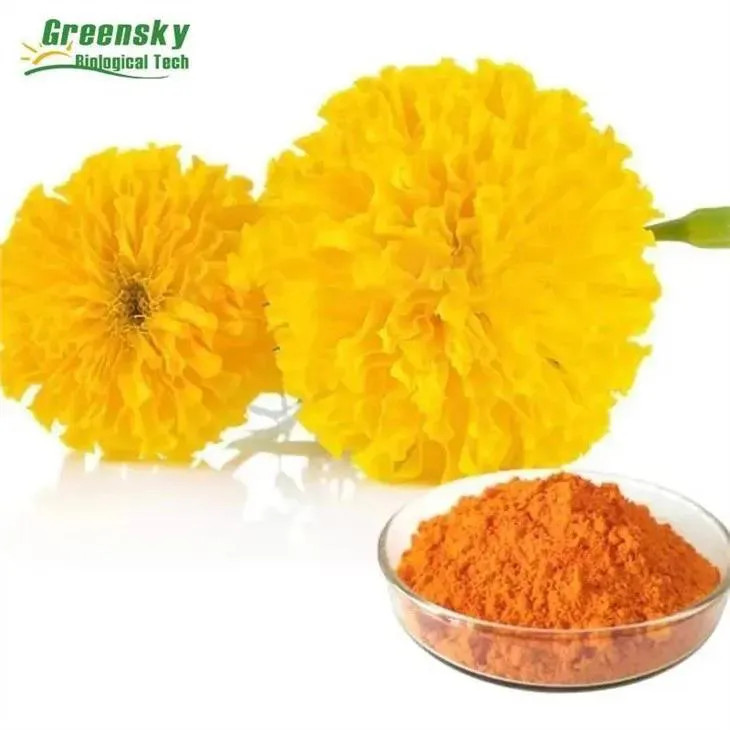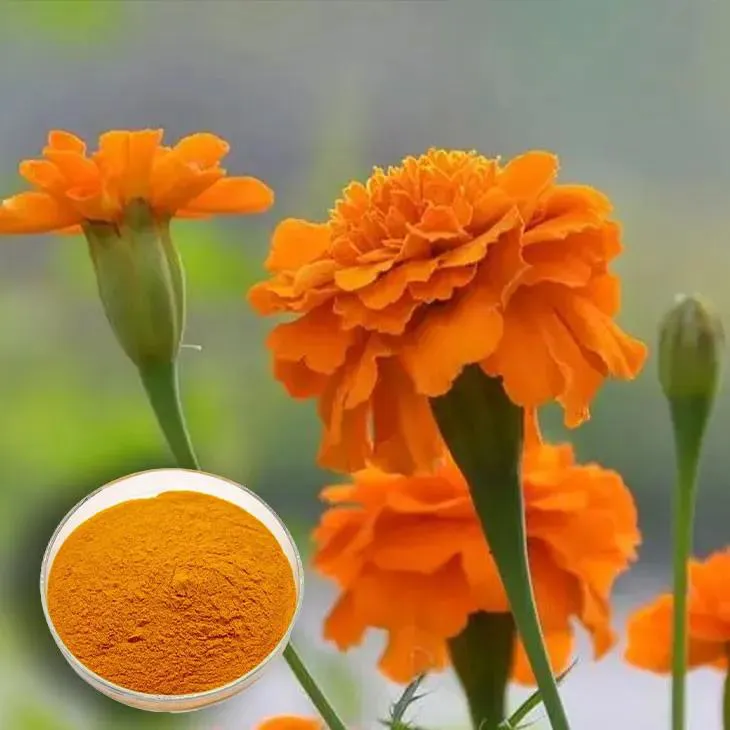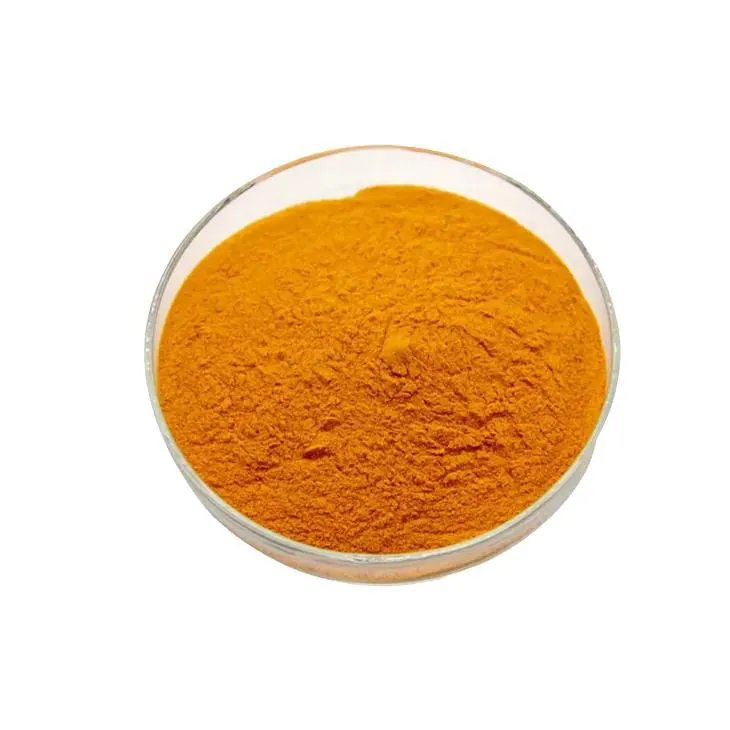- 0086-571-85302990
- sales@greenskybio.com
Organic Supercritical CO2 Extraction of Marigold Extracts
2024-11-29

1. Introduction to Marigold
Marigold, a well - known plant, has been the focus of much research in recent years. It is rich in a variety of bioactive compounds, among which lutein and zeaxanthin are particularly prominent. These compounds play important roles in various fields. Lutein, for example, is known for its antioxidant properties and is beneficial for eye health. Zeaxanthin also has similar functions, and together they contribute to the overall value of Marigold Extracts.

2. Traditional Extraction Methods and Their Limitations
Traditional extraction methods for Marigold Extracts have been in use for a long time. However, they come with several limitations.
2.1 Solvent - based Extraction
Solvent - based extraction methods often use organic solvents such as hexane or ethanol. One of the main problems is the potential for solvent residue in the final product. This is a significant concern, especially in industries such as food, pharmaceuticals, and cosmetics, where strict regulations are in place regarding the presence of solvents. For example, in the food industry, even a small amount of residual solvent can pose a risk to human health.
2.2 High - Temperature Extraction
Some traditional extraction techniques require high temperatures. This can be detrimental to the thermally - sensitive components present in marigold. High - temperature extraction may cause the degradation of bioactive compounds like lutein and zeaxanthin. As a result, the quality and effectiveness of the Marigold Extract may be significantly reduced.

3. Supercritical CO2 Extraction: An Overview
Supercritical CO2 extraction is a revolutionary technique that has emerged as a more efficient and environmentally - friendly alternative to traditional methods.
3.1 The Principle of Supercritical CO2
Carbon dioxide (CO2) under supercritical conditions exhibits unique properties. At a certain temperature and pressure above its critical point, CO2 has the properties of both a gas and a liquid. It has a high diffusivity like a gas, which allows it to penetrate the marigold matrix easily, and a high solvating power similar to a liquid. This enables it to dissolve and extract the desired compounds effectively.
3.2 Equipment Used in Supercritical CO2 Extraction
The equipment for supercritical CO2 extraction typically consists of a high - pressure pump, an extraction vessel, a separator, and a system for controlling temperature and pressure. The high - pressure pump is used to pressurize the CO2 to the supercritical state. The extraction vessel contains the marigold material, where the extraction takes place. The separator is then used to separate the extracted compounds from the supercritical CO2. The precise control of temperature and pressure is crucial for optimizing the extraction process.

4. Advantages of Supercritical CO2 Extraction for Marigold Extracts
Supercritical CO2 extraction offers several distinct advantages when it comes to obtaining marigold extracts.
4.1 Preservation of Thermally - Sensitive Components
As mentioned earlier, this extraction method operates at a relatively low temperature. This is a crucial advantage as it helps to preserve the thermally - sensitive components of marigold, such as lutein and zeaxanthin. By maintaining the integrity of these bioactive compounds, the quality of the marigold extract is enhanced, and its potential applications in various industries are broadened.
4.2 Minimal Solvent Residue
Since CO2 is a gas at normal conditions, it can be easily removed from the extract after the extraction process. This results in minimal solvent residue in the final marigold extract. This is highly desirable in industries where purity and safety are of utmost importance, such as the food, pharmaceutical, and cosmetic industries. For instance, in the pharmaceutical industry, products with low solvent residue are less likely to cause adverse reactions in patients.
4.3 High - Purity Extracts
The selectivity of supercritical CO2 extraction allows for the isolation of specific compounds from marigold. This can lead to the production of high - purity extracts. The ability to target and extract only the desired bioactive compounds means that the final product has a higher concentration of useful components, making it more effective in various applications. For example, in the cosmetic industry, high - purity marigold extracts can be used to develop more potent anti - aging products.
4.4 Environmentally - Friendly
CO2 is a non - toxic and non - flammable gas. Moreover, it is a by - product of many industrial processes, so using it for extraction does not contribute significantly to greenhouse gas emissions. In contrast to some traditional solvents which may be harmful to the environment, supercritical CO2 extraction is a more sustainable option. This is becoming increasingly important as environmental regulations become more stringent worldwide.

5. The Extraction Process in Detail
The supercritical CO2 extraction process of marigold extracts can be divided into several steps:
-
Preparation of Marigold Material: The marigold flowers or parts of the plant are first collected and dried. This drying process should be carefully controlled to ensure that the bioactive compounds are not damaged. The dried marigold material is then ground into a fine powder to increase the surface area available for extraction.
-
Pressurization of CO2: The CO2 gas is pressurized using a high - pressure pump. The pressure is increased until it reaches the supercritical state. The appropriate pressure range for marigold extraction typically varies depending on the specific equipment and the desired extraction efficiency.
-
Extraction in the Vessel: The supercritical CO2 is then passed through the extraction vessel containing the powdered marigold material. During this process, the CO2 dissolves the bioactive compounds, such as lutein and zeaxanthin, from the marigold. The extraction time is an important parameter that needs to be optimized. Too short an extraction time may result in incomplete extraction, while too long a time may lead to the extraction of unwanted compounds.
-
Separation of the Extract: After the extraction in the vessel, the supercritical CO2 - containing - the - dissolved - compounds is passed into the separator. Here, the pressure and temperature are adjusted to cause the CO2 to return to a gaseous state, leaving behind the extracted marigold compounds. The separated CO2 can then be recycled and reused in the extraction process.
6. Applications of Marigold Extracts Obtained by Supercritical CO2 Extraction
Marigold extracts obtained through supercritical CO2 extraction have a wide range of applications in different industries.
6.1 Food Industry
In the food industry, marigold extracts can be used as a natural food coloring agent. The lutein and zeaxanthin present in the extracts can also be added to functional foods and dietary supplements. For example, they can be incorporated into products designed to promote eye health. Since the extracts obtained by supercritical CO2 extraction have minimal solvent residue, they are safe for consumption and meet the strict quality standards of the food industry.
6.2 Pharmaceutical Industry
The antioxidant properties of lutein and zeaxanthin in marigold extracts make them potentially useful in the pharmaceutical industry. They may be used in the development of drugs or nutraceuticals for treating or preventing eye - related diseases. The high - purity extracts obtained by supercritical CO2 extraction are ideal for pharmaceutical applications as they can ensure the effectiveness and safety of the final products.
6.3 Cosmetic Industry
Marigold extracts are highly valued in the cosmetic industry. They can be used in various skincare products, such as creams, lotions, and serums. The anti - aging and antioxidant properties of the extracts can help to reduce wrinkles, improve skin elasticity, and protect the skin from environmental damage. Supercritical CO2 extraction provides high - quality extracts that can enhance the performance of cosmetic products.
7. Future Perspectives
The use of supercritical CO2 extraction for marigold extracts is likely to grow in the future.
7.1 Research and Development
There is still room for further research and development in this area. Scientists may explore ways to optimize the extraction process further, for example, by finding the most suitable extraction parameters for different varieties of marigold. Additionally, research could focus on the discovery of new bioactive compounds in marigold and how to extract them more efficiently using supercritical CO2 extraction.
7.2 Industrial Expansion
As the demand for high - quality, natural products increases in various industries, the industrial scale - up of supercritical CO2 extraction of marigold extracts is expected. This will require improvements in equipment design and cost - effectiveness to make the process more economically viable on a large scale. With the development of more efficient and affordable supercritical CO2 extraction technology, the production of marigold extracts is likely to increase, meeting the growing market demand.
8. Conclusion
Supercritical CO2 extraction of marigold extracts is a highly promising technique. It overcomes the limitations of traditional extraction methods by offering advantages such as preservation of thermally - sensitive components, minimal solvent residue, high - purity extracts, and environmental - friendliness. The extracts obtained through this method have diverse applications in the food, pharmaceutical, and cosmetic industries. With continued research and development, and the expansion of industrial applications, supercritical CO2 extraction of marigold extracts is set to play an increasingly important role in the future.
FAQ:
What are the main bioactive compounds in marigold?
The main bioactive compounds in marigold are lutein and zeaxanthin.
Why is supercritical CO2 extraction considered environmentally - friendly?
Supercritical CO2 extraction is considered environmentally - friendly because CO2 is a non - toxic, non - flammable gas that is easily available. Also, it can achieve high - purity extracts with minimal solvent residue, reducing the environmental impact associated with solvent waste.
How does supercritical CO2 extraction preserve the thermally - sensitive components of marigold?
Supercritical CO2 extraction operates at a relatively low temperature. This low - temperature operation helps to preserve the thermally - sensitive components of marigold as it reduces the risk of thermal degradation.
What industries can benefit from the organic supercritical CO2 extraction of marigold extracts?
The food, pharmaceutical and cosmetic industries can benefit from the organic supercritical CO2 extraction of marigold extracts. These industries have strict requirements for purity and minimal solvent residue, which this extraction method can meet.
What are the advantages of supercritical CO2 extraction over traditional extraction methods?
Supercritical CO2 extraction has several advantages over traditional extraction methods. It operates at a relatively low temperature, which helps to preserve thermally - sensitive components. It can also achieve high - purity extracts with minimal solvent residue.
Related literature
- Supercritical Fluid Extraction of Bioactive Compounds from Marigold: A Review"
- "Advances in Supercritical CO2 Extraction of Marigold for Lutein and Zeaxanthin"
- "Organic Extraction of Marigold Extracts: A Comparison between Supercritical CO2 and Conventional Methods"
- ▶ Hesperidin
- ▶ citrus bioflavonoids
- ▶ plant extract
- ▶ lycopene
- ▶ Diosmin
- ▶ Grape seed extract
- ▶ Sea buckthorn Juice Powder
- ▶ Beetroot powder
- ▶ Hops Extract
- ▶ Artichoke Extract
- ▶ Reishi mushroom extract
- ▶ Astaxanthin
- ▶ Green Tea Extract
- ▶ Curcumin Extract
- ▶ Horse Chestnut Extract
- ▶ Other Problems
- ▶ Boswellia Serrata Extract
- ▶ Resveratrol Extract
- ▶ Marigold Extract
- ▶ Grape Leaf Extract
- ▶ blog3
- ▶ blog4
-
Organic Saw Palmetto Extract Powder Factory.
2024-11-29
-
Suppliers of Organic Açai Extract Powder.
2024-11-29
-
Extraction process of black pepper extract.
2024-11-29
-
Wholesale L - Tyrosine Suppliers.
2024-11-29
-
The best milk thistle extract in 2024.
2024-11-29
-
High - quality kidney bean extract products.
2024-11-29
-
The best aged garlic extract on the market.
2024-11-29
-
Boswellia Serrata Extract
2024-11-29
-
Shikonin
2024-11-29
-
Curcuma Longa Extract
2024-11-29
-
Acerola Juice Powder
2024-11-29
-
Sugarcane Extract
2024-11-29
-
Feverfew Extract
2024-11-29
-
Saffron Extract Powder
2024-11-29
-
Red Vine Extract
2024-11-29
-
Eyebright Extract
2024-11-29
-
Sea buckthorn Juice Powder
2024-11-29





















